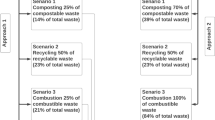Abstract
Goal, Scope and Background
The disposal phase of a product’s life cycle in LCA is often neglected or based on coarse indicators like ‘kilogram waste’. The goal of report No. 13 of the ecoinvent project (Doka 2003) is to create detailed Life Cycle Inventories of waste disposal processes. The purpose of this paper is to give an overview of the models behind the waste disposal inventories in ecoinvent, to present exemplary results and to discuss the assessment of long-term emissions. This paper does not present a particular LCA study. Inventories are compiled for many different materials and various disposal technologies. Considered disposal technologies are municipal incineration and different landfill types, including sanitary landfills, hazardous waste incineration, waste deposits in deep salt mines, surface spreading of sludges, municipal wastewater treatment, and building dismantling. The inventoried technologies are largely based on Swiss plants. Inventories can be used for assessment of the disposal of common, generic waste materials like paper, plastics, packaging etc. Inventories are also used within the ecoinvent database itself to inventory the disposal of specific wastes generated during the production phase. Inventories relate as far as possible to the specific chemical composition of the waste material (waste-specific burdens). Certain expenditures are not related to the waste composition and are inventoried with average values (process-specific burdens).
Methods
The disposal models are based on previous work, partly used in earlier versions of ecoinvent/ETH LCI data. Important improvements were the extension of the number of considered chemical elements to 41 throughout all disposal models and new landfill models based on field data. New inventories are compiled for waste deposits in deep salt mines and building material disposal. Along with the ecoinvent data and the reports, also Excel-based software tools were created, which allow ecoinvent members to calculate waste disposal inventories from arbitrary waste compositions. The modelling of long-term emissions from landfills is a crucial part in any waste disposal process. In ecoinvent long-term emissions are defined as emissions occurring 100 years after present. They are reported in separate emission categories. The landfill inventories include long-term emissions with a time horizon of 60’000 years after present.
Results and Discussion
As in earlier studies, the landfills prove to be generally relevant disposal processes, as also incineration and wastewater treatment processes produce landfilled wastes. Heavy metals tend to concentrate in landfills and are washed out to a varying degree over time. Long-term emissions usually represent an important burden from landfills. Comparisons between burdens from production of materials and the burdens from their disposal show that disposal has a certain relevance.
Conclusion
The disposal phase should by default be included in LCA studies. The use of a material not only necessitates its production, but also requires its disposal. The created inventories and user tools facilitate heeding the disposal phase with a similar level of detail as production processes. The risk of LCA-based decisions shifting burdens from the production or use phase to the disposal phase because of data gaps can therefore be diminished.
Recommendation and Perspective
Future improvements should include the modelling of metal ore refining waste (tailings) which is currently neglected in ecoinvent, but is likely to be relevant for metals production. The disposal technologies considered here are those of developed Western countries. Disposal in other parts of the World can differ distinctly, for logistic, climatic and economic reasons. The cross-examination of landfill models to LCIA soil fate models could be advantageous. Currently only chemical elements, like copper, zinc, nitrogen etc. are heeded by the disposal models. A possible extension could be the modelling of the behaviour of chemical compounds, like dioxins or other hydrocarbons.
Similar content being viewed by others
Author information
Authors and Affiliations
Corresponding author
Rights and permissions
About this article
Cite this article
Doka, G., Hischier, R. Waste Treatment and Assessment of Long-Term Emissions (8pp). Int J Life Cycle Assessment 10, 77–84 (2005). https://doi.org/10.1065/lca2004.12.181.9
Received:
Accepted:
Published:
Issue Date:
DOI: https://doi.org/10.1065/lca2004.12.181.9




